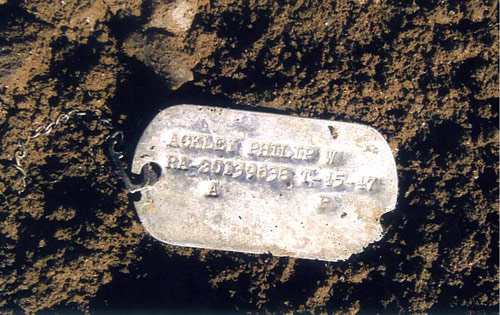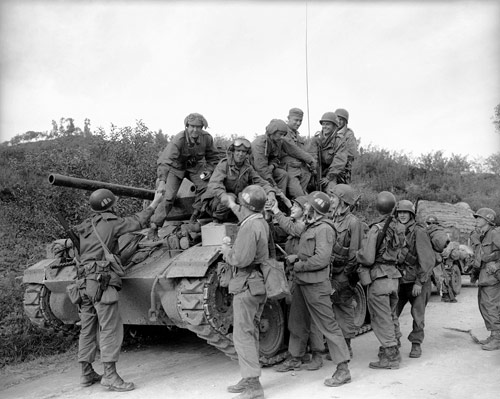Lost battalion of Unsan

A photograph of Pfc. Philip W. Ackley's Korean War dog tag, found in the Unsan battlefield area, was turned over to the U.S. by North Korea in January.

U.S. paratroopers greet First Cavalry Division tank crewmen at Sukchon, North Korea, in 1950. A week later the division's 8th Cavalry Regiment was caught in a trap by two Chinese divisions at Unsan, suffering heavy casualties. About 260 Unsan soldiers remain listed as missing in action.


SEOUL » Trapped by two Chinese divisions, troops of the 8th U.S. Cavalry Regiment were left to die in far northern Korea, abandoned by the U.S. command in a Korean War episode viewed as one of the most troubling in American military history.
Sixty years later those soldiers, the lost battalion of Unsan, are stranded anew.
North Korea is offering fresh clues to their remains. American teams are ready to re-enter the North to dig for them. But for five years the U.S. government has refused to work with North Korea to recover the men of Unsan and others among more than 8,000 Americans missing in action from the 1950-53 war.
Now, under pressure from MIA family groups, the Obama administration is said to be moving slowly to reverse the Bush administration’s suspension of the joint recovery program, a step taken in 2005 as the North Korean nuclear crisis dragged on.
"If I had a direct line in to the president, I would say, ‘Please reinstitute this program. There are families that need closure,’" said Ruth Davis, 61, of Palestine, Texas, whose uncle Sgt. 1st Class Benny Don Rogers has been listed as MIA since Chinese attackers overran his company — I Company, 8th Cavalry — at Unsan in late 1950.
It was one of Rogers’ I Company comrades, Pfc. Philip W. Ackley of Hillsboro, N.H., whose identifying dog tag appeared in a photo the North Koreans handed over at Korea’s Panmunjom truce village in January of this year, the 60th since the war started. The North Koreans also delivered photos of remains, a stark reminder that Unsan’s dead still wait to come home.
Don't miss out on what's happening!
Stay in touch with breaking news, as it happens, conveniently in your email inbox. It's FREE!
The devastating losses at Unsan in early November 1950 came as China intervened to fend off a final North Korean defeat. In a last letter home, dated Oct. 30, Rogers told his parents, "It is a lot better over here, but it’s not over yet."
The U.S. command had ignored intelligence reports that China’s army was moving south, and the 8th Cavalry had been sent too far north, just 50 miles from China, where they stumbled into a closing enemy vise.
Higher headquarters rejected requests for a pullback, then refused to send artillery forward to support a rescue. Finally, it ordered the rescue force withdrawn.
Two of the 8th Cavalry’s three battalions escaped, with heavy losses. But only small bands from the five companies of the doomed 3rd Battalion made it out as waves of Chinese infantry attacked their 200-yard-wide defense perimeter.
The 8th Cavalry’s abandonment at Unsan became an infamous chapter in Army annals — "one of the most shameful and little-known incidents in U.S. military history," wrote Korean War historian Jack J. Gifford.
About 600 of the 3rd Battalion’s 800 men were lost, about half believed killed and half captured, many of whom died in Chinese-run prison camps.
The U.S. and North Korea established the MIA search in 1996. Over nine years the joint teams recovered 229 sets of remains believed to be those of Americans, including 14 identified as 3rd Battalion men.
But an estimated 260 U.S. dead are still unaccounted for at Unsan, among almost 4,600 U.S. MIAs in North Korea, the Pentagon’s Defense POW/MIA Office says.
When then-Defense Secretary Donald H. Rumsfeld suspended the program in 2005, officials cited what they said were concerns about the security of American personnel working on the territory of a longtime U.S. adversary.
Richard Lawless, the former Pentagon official who recommended the move, defends it today, saying U.S. field teams "were potential high-value hostages as the North Korean nuclear crisis deepened."
The MIA support groups rejected that rationale, saying they suspected President George W. Bush’s administration instead wanted to break the lone working link with North Korea and pressure Pyongyang in the nuclear showdown.
"This safety aspect from the Pentagon sounds like so much hogwash," said former 3rd Battalion Sgt. Robert J. Earl, 82, of Federal Way, Wash. Earl was not at Unsan, having been wounded earlier, and for years he has sought information on his 8th Cavalry mortar platoon, all of whom may have perished.
Stepping up their lobbying in Washington last year, the MIA families appear to have made headway with the new administration.
Larry Greer, spokesman for the Defense POW/MIA Office, said officials are evaluating a possible resumption. Other administration officials have pointedly referred to the recovery program as a humanitarian mission unrelated to political considerations. But the recent furor over North Korea’s alleged torpedoing of a South Korean warship "has stopped everything in its tracks for now," Frank Metersky, 77, a Marine veteran of the war, said.
Nevertheless, U.S. specialists sound ready.
"We are prepared to resume operations in (North Korea) and will request access to the Unsan area," the Joint POW/MIA Accounting Command in Hawaii, home to the field teams, said in its latest annual report.
Its forensic experts, meanwhile, continue the work of DNA identification of remains returned years ago, like those of Master Sgt. Roy Earl Head of the 7th Infantry Division, finally identified, brought home and buried June 5 in Grit Hill, Va.
"It’s remarkable, after 59 years," said brother David Head, 71, of Kingsport, Tenn. His mind turned sympathetically to others.
"There are still a lot more families out there who might not ever find out or get the closure we will get."




